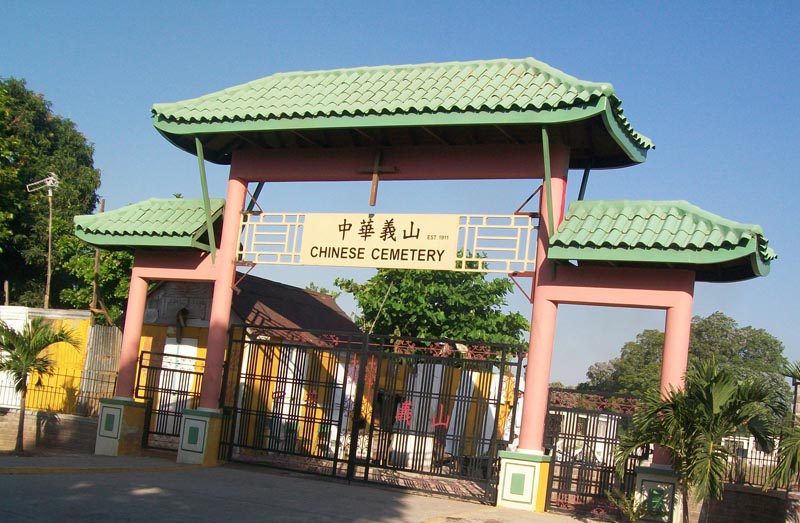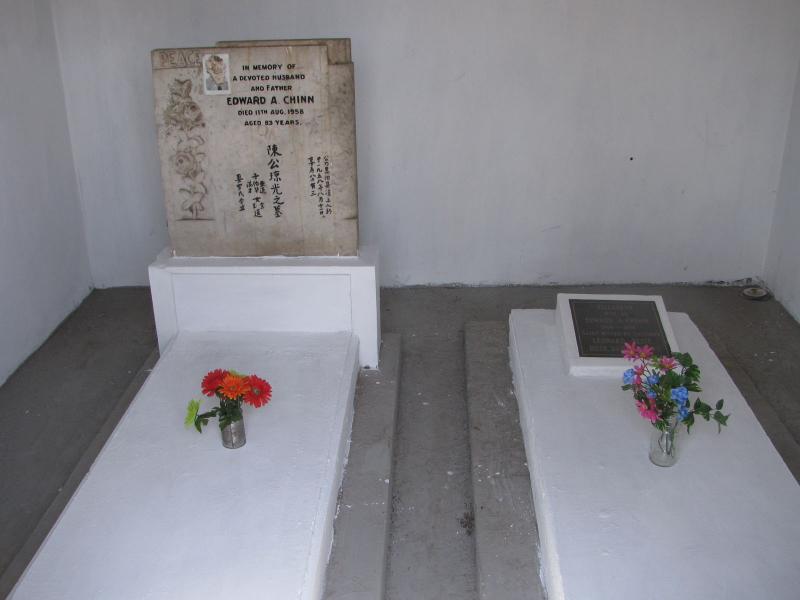
 The Lignum Vitae tree — Jamaica’s national tree — shades the grave of Albert Hosang in the Chinese cemetery in Kingston, Jamaica. Photo: Lisa Biagiotti |
Lisa Biagiotti is currently reporting on HIV/AIDS, sexuality and young gay men in Jamaica. On Saturday, she visited her grandfather’s grave in the Chinese cemetery in Kingston. She shares a personal story of death and renewal of the Chinese community in Jamaica.
I never met my grandfather, Albert Hosang, but I knew he was buried in the Chinese cemetery in Kingston, Jamaica. The 11-acre cemetery serves as the buffer zone for three main gangs in one of Kingston’s most volatile neighborhoods.
Before the Chinese Benevolent Association (CBA) erected a wall around the cemetery, it was a blanket battleground. People slept in graves and pillaged marble tombstones, preventing many Chinese Jamaicans from visiting the final resting places of their relatives.
The cemetery is a reminder of the Chinese presence in Jamaica since 1854. After slavery was abolished in Jamaica, British landowners recruited the Chinese — specifically the peasant, nomadic Hakka Chinese from the Guandong province outside Hong Kong. They came as indentured laborers, but soon rose through the economic and social ranks of Jamaican society, settling in downtown Kingston and throughout the island as traders, shopkeepers and bakers.
From the beginning, the Chinese mixed with the local population and converted from Buddhism to Christianity. At one point, some estimate the Chinese population reached 20,000, but it’s difficult to calculate a precise count because many Chinese are a blend of other ethnic backgrounds like black Jamaican, white European, South Asian, Lebanese, Syrian and Jewish.
When independence from British rule came in 1962, the Chinese fully integrated into Jamaican society. The second and third generations identified more as Jamaican than Chinese. They didn’t speak the old Hakka dialect, but spoke Jamaican patois. The CBA in Jamaica is trying to revive haunts of Chinese culture with Mandarin language lessons, Chinese socials, badminton, Kung Fu and other traditional Chinese celebrations.
There is also a new wave of Chinese immigrants in Jamaica today. Like their Chinese ancestors 150 years ago, they are setting up shops in downtown Kingston. When I walked into Chun Lai’s shop on Princess Street, no one spoke patois (yet), and all the goods were made in China.
At 10:00 on Saturday morning, I sat at the foot of my grandfather’s grave in the 99-year-old Chinese cemetery while resident expert David Chang read the Chinese characters on the tombstone. (My grandfather died at age 46, but the Chinese characters read 49 — it’s common to have errors like these as the language slipped away from the Chinese Jamaicans.) David read from top to bottom, right to left: The town and province my grandfather’s family came from in China, the names of his parents, brothers and wife. Then he said, “And 10? Ten children?” and turned to me.
I nodded, “Yes, 10 children.” And I looked down at my right hand, at the worn, barely-beveled ring my Aunt Paula sent me in a plastic bag a few weeks ago. I sighed and thought of her as she waged her final battle with cancer. I patted her father’s grave and heard her slim gold band tap the white tile.
My aunt, Paula (Hosang) Sperrazza, died at 1:30 p.m. that very same day. I’m not sure if my visit was karmic or auspicious — maybe it just is. She was a courageous and brilliant woman who began her life 62 years ago in the Chinese Jamaican community in Kingston.
Rest in peace Paula Sperrazza and Albert Hosang.
Last edited by Admin on Mon 12 Apr 2010 - 20:42; edited 1 time in total






